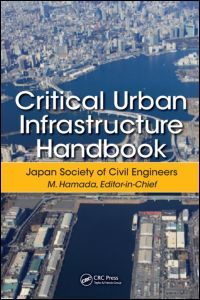Description
Critical Urban Infrastructure Handbook
Coordinator: Hamada Masanori
Language: English
Subject for Critical Urban Infrastructure Handbook:
Keywords
Ca Bl; Pipe’s Internal Surface; Buried pipeline system; Seismic Intensity; Distribution network; High Pressure Gas Pipelines; Urban Lifeline system; Cable Tunnel; Underground structure; Rigid Polyvinyl Chloride Pipes; Seismic design of lifelines; Distribution Pipelines; Seismic Design; DCIP; Sanitary Wastewater; Lifeline Systems; Water Pipeline System; Gas Distribution System; Ground Motions; Shield Tunnel Method; Seismic Damage; Combined Sewer; Substation Equipment; Urban Lifelines; Construction Method; Electric Power System; Aseismic Measures; Shield Tunnel; Shield Method; Li Ne
· 17.8x25.4 cm · Hardback
Description
/li>Contents
/li>Readership
/li>Biography
/li>
Represents the State of the Art in Urban Lifeline Engineering
Urban lifelines are buried or aboveground network systems used for water, sewerage, gas, power, and telecommunications. Dedicated to preserving the functions of lifeline systems against natural disasters, the Critical Urban Infrastructure Handbook is a vital compilation of urban utility management. This text utilizes the input of leading experts who have extensive experience with natural disasters, and provides a better understanding of the technical and legal framework of infrastructure construction and operation.
Examine the Damage Data of Urban Lifelines Suffered by Seismic Disasters
The book addresses water supply and sewerage, power, gas, telecommunications joint utility corridor lifeline facilities, and other critical civil infrastructure lifelines. It emphasizes the importance of the resilience of lifeline systems against natural disasters in protecting human lives and supporting survivors of disasters as well as in promptly recovering and reconstructing the affected areas. In addition, it also describes the structural damage of nodes and links, as well as the functional damage of the lifeline system from the viewpoint of disaster prevention and mitigation measures.
This valuable work consists of 24 chapters in four sections covering:
- Design and construction of various lifeline facilities
- Maintenance
- Disaster management
- Environmental protection
- Disaster and emergency recovery measures
- Urban planning
- Life cycle costing
- GIS analysis of lifeline systems
- Computerized integrated management systems
- New materials and technologies
The Critical Urban Infrastructure Handbook comprehensively describes common issues of lifeline systems, and provides practical information to engineers and industry professionals involved in the planning, construction, and maintenance of lifeline systems.
Section I General Remarks of Lifeline Services. Water Pipeline Systems. Sewerage System. Natural Gas Distribution System. Electric Power System. Telecommunication System. Section II Construction Technology of Lifeline Pipelines and Its Facilities. Construction Methods for Lifeline Systems. Water Pipeline Systems. Sewerage System. Natural Gas Distribution System. Electric Power System. Telecommunication System. Section III Maintenance Technologies of Lifelines. Water Pipeline Systems. Sewerage System. Natural Gas Distribution System. Electric Power System. Telecommunication System. Section IV Disaster Prevention and Mitigation. Technologies of Lifelines. General. Water Supply Systems. Sewerage Systems. Natural Gas Distribution Systems. Electric Power System. Telecommunication System. Index.
Masanori Hamada is internationally recognized for his contributions to earthquake and geotechnical engineering. After receiving his undergraduate degree from Waseda University and Master’s and Ph.D. degrees from Tokyo University, he worked as a design engineer for a decade and a half in the civil engineering department of Taisei Corporation, one of the largest general contractor firms in Japan. He then served as a Professor in Tokai University for a decade before moving to Waseda University, where he served as Professor for two decades before retiring in 2014. During this period he served as the President of the Institute of Social Safety Science, the Japan Society of Civil Engineers and the Japan Association for Earthquake Engineering. He has served for more than a decade as a Member of the Science Council of Japan and since 2010 as a Board Member of the Engineering Academy of Japan. He has received a number of major awards, including the Distinguished Achievement Award of the Japan Society of Civil Engineers, and the Minister’s Award of the Ministry of Economics and Industry of Japan.
Takeshi Koike served as Professor of Structural Dynamics for Civil Engineering Systems, Kyoto University (Japan), and was a Professor of Tokyo City University (Tokyo). He is an expert for the structural analysis, risk assessment and design formulation of infrastructures and lifeline network systems for natural hazards risk. He has engaged in many international research projects on seismic hazard and vulnerability analysis of lifeline network systems which include water, gas and electric power systems in the Middle East counties and Philippines. As a Professional Engineer, he consults to the pipe fabricating industry, city gas supply companies and water service agencies in Japan. And also as an Academic Advisor of Japan International Cooperation Agency (JICA), he is working for the Project : "Enhancement for Engineering Higher Education in Myanmar".
T




